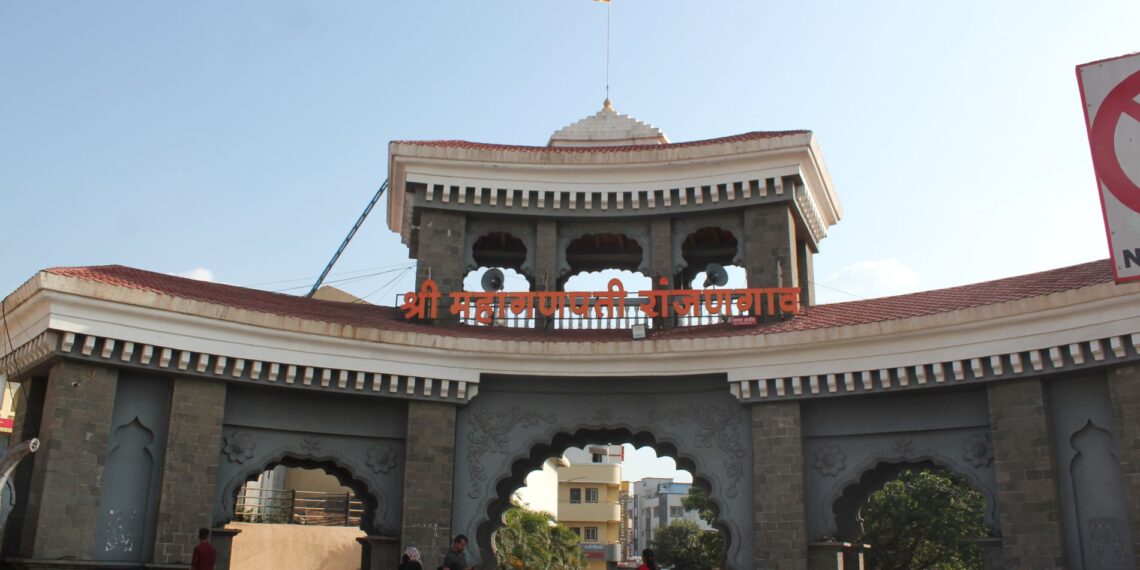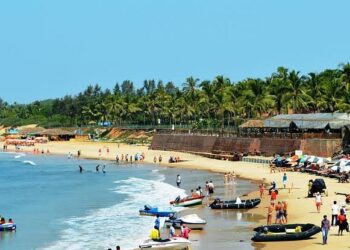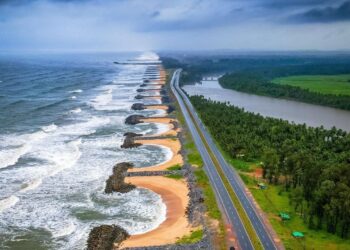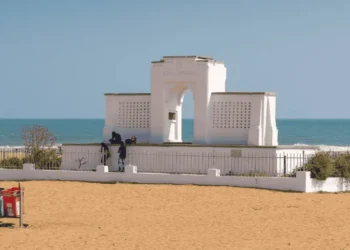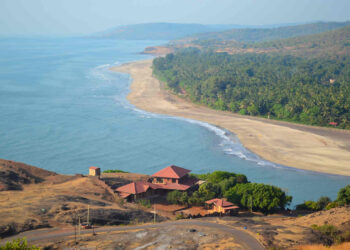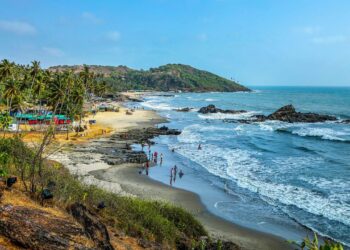Maharashtra, a divine land of ancient Hindu culture and legacy, is home to many holy temples built under great kings and saints. The Ranjangaon Ganpati temple is located in Shirur taluka about 50 km from Pune and is set near the Kukdi River. Covering roughly 2 acres it is the eighth temple visited by devotees who set out on the divine Ashtavinayak Yatra.
Historical Overview
The Mahaganapati Temple has ancient history, reaching back to the 9th century, though some say worship began earlier. Ranjangaon, a quiet village 50 km from Pune, was a spiritual spot. Old texts and local talk credit the temple’s origins to the Chalukya dynasty, with later additions by a devotee named Sardar Kibe in the 1700s. The Peshwas, Maratha rulers who revered Ganesha, expanded the temple with halls and walls in the 1700s, as stone writings show. The temple faced damage during invasions in the 1600s, but devotees hid the Ganesha idol in a nearby cave to keep it safe. It was rebuilt in the 1800s with help from local chieftains.
Mythological Importance
The form of Managanpati there is portrayed, seated on a lotus, flanked by his consorts Siddhi (spiritual power) and Riddhi (prosperity). The murti of Lord Ganesha is also named as ‘Mahotkat’, and it is said that the murti has 10 trunks and 20 hands. Mahaganpati is depicted as having eight, ten or twelve arms. It is after invoking this form of Ganpati that Shiva vanquished the demon Tripurasur and so he is also known as Tripurarivade Mahaganpati.
It is believed that the place where Lord Shiva invoked Lord Ganesha and defeated Tripurasura is Ranjangaon (the word Ranjan means the delighted one), prior to which it had the name of Manipur. Ganesha blessed him, earning the name Mahaganapati, or “great Ganesha.” Another tale from the Mudgala Purana says Ganesha manifested in Ranjangaon to protect sages from evil forces. The self-manifested idol, adorned with precious stones, is said to hold divine power, granting success to those who pray with faith. In the Ganapatya sect, saints like Morya Gosavi are said to have worshipped here, attaining spiritual heights.
Temple Structure and Design
Crafted in the Hemadpanthi style, a 13th-century Maratha art, the Mahaganapati Temple in Ranjangaon, Maharashtra, sits on a raised platform, with a towering stone dome and thick walls. The gopuram, restored in the 1800s, stands proud with stone carvings of Ganesha with ten arms, sages praying, and elephants, framed by lotus and vine patterns. Painted in soft cream and ochre, it’s capped with a golden kalasa that catches the morning light. The sanctum houses a black-stone Ganesha idol, draped in gold cloth and fresh garlands, set beneath a white-painted vimana, its stepped roof symbolizing purity. The sanctum’s walls, smoothed by time, carry faint Peshwa-era etchings of Ganesha’s tales, glowing under oil lamps.
Small shrines for Shiva, Parvati, and Hanuman are scattered across the grounds, each carved from local basalt and sheltered by open stone canopies. The Shiva shrine, near the entrance, holds a small lingam, its base etched with snake motifs. The Parvati shrine, by the courtyard, shows a gentle goddess with a lotus, inviting prayers for peace. The Hanuman shrine, facing Ganesha, depicts him kneeling, hands folded in devotion. These shrines, though modest, tie the temple’s worship together, offering varied paths to faith.
Set near the Kukdi River, the temple is reached by a short stone path from Ranjangaon village, winding past neem and peepal trees. The courtyard, paved with uneven basalt, feels open yet sacred, fringed by old banyan trees that cast dappled shade. A small tank, fed by a nearby stream, is used for ritual dips, its edges carved with fish shapes, a Peshwa touch.
Rituals and Festivals
The temple celebrates festivals dedicated to Ganesha. Ganesh Chaturthi in August or September is the grandest among them, marking Ganesha’s birth, with modak offerings and marches. Magh Shukla Chaturthi in January or February has homams (fire rituals) and idol worship. Sankashti Chaturthi, every month, sees lamp-lighting by the sanctum. Daily worship covers Suprabhata Seva (morning prayers), Archana (offerings), and Deeparadhana (lamp ritual). Services like Abhishekam and Ganapati Homam can be booked at the temple office. A prasad stall gives free laddoos for devotees. Modak Archana, giving sweets on Wednesdays, is for pleasing him and getting his blessings.
Information for Travelers
Hours and Entry: Open daily, 5:00 AM to 12:00 PM, then 3:00 PM to 9:00 PM. Entry is free, but rituals cost 50-300 rupees.
Clothing: Wear simple clothes covering shoulders and knees. Men doing rituals wear dhotis and go bare-chested, as custom.
How to Get There:
Air: Pune International Airport, 50 km away, is nearest. Taxis take 1 hour, costing 1500-2000 rupees.
Train: Uruli Railway Station, 20 km away, links to Pune (30 minutes) and Mumbai (3 hours). Autos to Ranjangaon cost 200-400 rupees.
Road: Ranjangaon is 50 km from Pune. Buses from Pune’s Swargate Bus Stand (1 hour) stop at Ranjangaon village, 1 km away. Autos cost 20-40 rupees.
Places to Stay: Ranjangaon has plain guesthouses like Bhakta Niwas (500-1000 rupees). Pune, 50 km away, has hotels like Hotel Shreyas (2000-4000 rupees). Stalls by the temple sell dosa, vada, and tea.
Best Time to Visit: October to March has good weather, 20-30°C. Weekdays are calm. Ganesh Chaturthi packs crowds, so book early.
Nearby Attractions: Siddhivinayak Temple, 80 km away in Siddhatek, is the second Ashtavinayak stop. Bhuleshwar Temple, 40 km away, is a historic Shiva shrine. Jejuri, 50 km away, hosts the Khandoba temple.
